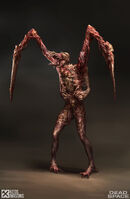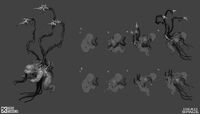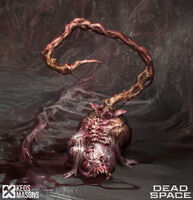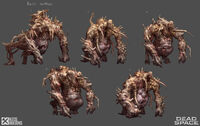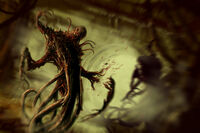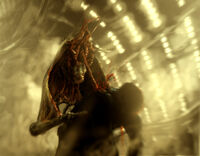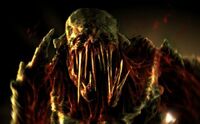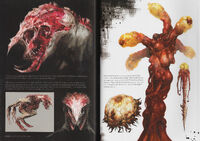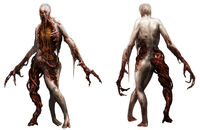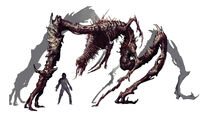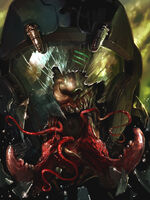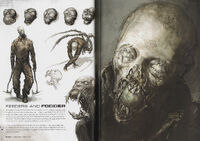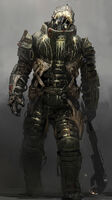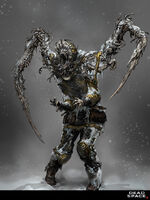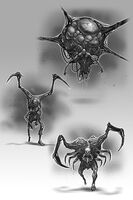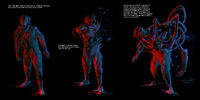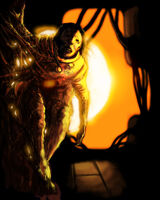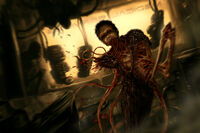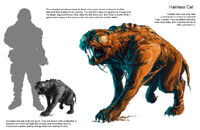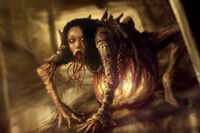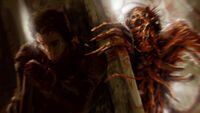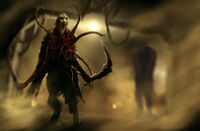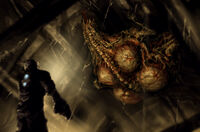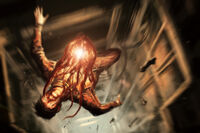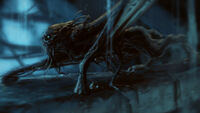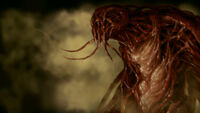| “ | Death is where we begin. Holy creatures, set us free.[1] | ” |
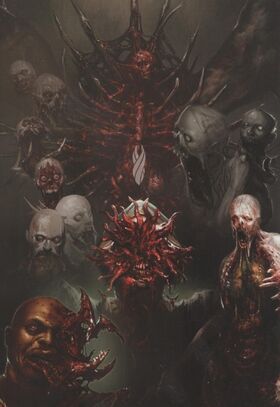
Necromorphs are reanimated corpses and other dead tissue reshaped into horrific new forms by a recombinant infection derived from a genetic code etched into and transmitted by the Markers.[2][3][4][5][6] The resulting creatures are extremely aggressive and will attack any living organism on sight.[7]
The sole purpose of all Necromorphs is to acquire more corpses to convert and spread the infection. They are believed to be the heralds of humanity's ascension by certain Unitologists and individuals suffering from Marker Dementia, but on a more practical level, they are the extremely dangerous result of the exposure of dead tissue to the Markers' electromagnetic signals.[4]
The Necromorphs are controlled via the Markers by a group of entities known as the Brethren Moons: massive, highly intelligent beings created after a Convergence Event is initiated by a Marker. The Necromorphs' sole drive is to create a mass of necrotic flesh that can be collected by the Markers during Convergence with the intention of creating another Brethren Moon, perpetuating the Moons' galaxy-wide cycle of extinction.[2]
Biology[]
Infection, Recombination and Reanimation[]
- "These children of the Marker - Kyne's "Necromorphs" - have provided all the material I could ask for. And the infector variant has provided a key insight: implanting the material directly into the brain renders optimal results."
- —Dr. Challus Mercer[8]
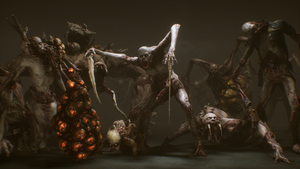
Several common types of Necromorph.
The generation of a Necromorph begins with the Markers and the highly concentrated electromagnetic signal that they broadcast. When it pulses, the signal can alter dead tissue within a certain range on a cellular level, converting it into pure Necromorph tissue and re-animating the corpse of the host organism into a deadly new form.[3][5][7] All Necromorph cells are animated by the Marker's carrier wave; without the Marker signal, the creatures cease to exist and degenerate into an organic sludge of their former host's DNA.[9]
The Marker signal also affects the minds of intelligent life forms, usually manifesting in them as dementia, resulting in homicidal/suicidal actions, essentially setting the stage for the coming Necromorph infection.[4] Additionally, the Markers' pulses can imprint a self-replicating signal containing blueprints in the minds of suitable individuals, thus leading them to build Red Markers and continue the cycle.[10][11][12][13]
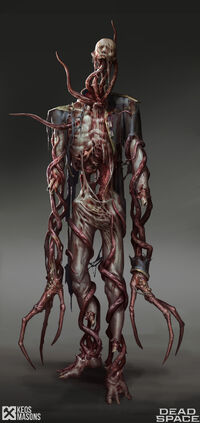
A Divider Necromorph.
The infection is also spread directly through the Necromorph pathogen – that is, the reanimated cells created by the Markers and which compose the Necromorphs. Typically, it is rapidly passed on via specialized Necromorphs such as Infectors and Swarm Infectors, which implant the material directly into corpses. As the Necromorph pathogen infects only necrotic tissue, living victims who come into contact with it typically do not undergo transformation unless it is inserted directly into their bodies, in which case they will undergo a gradual transformation as they slowly die, their internal organs being killed off and taken over one by one.[14] This can be seen in the case of Brant Harris, who transformed into a regenerating Necromorph, and in the case of S.C.A.F. soldiers who consumed Necromorph flesh, causing them to turn into a Wendigo-like Necromorph form known as the Feeder.
Once the host is dead, the recombinant properties of the infection take hold. The process is extraordinarily rapid, and predictably violent. Cellular functions go into a self-destructive overdrive, creating new biologically active compounds which are then metabolized by reanimated flesh to fuel further mutations. Bones are broken, put together in new configurations, or reshaped into entirely new forms.
The transformation can take place in a matter of seconds, and the process generates tremendous amounts of heat. More often than not, the violently spasming corpses become so hot that stagnant blood begins to boil in the veins and arteries, rupturing the skin. Formerly vital organs (such as parts of the digestive system) that are no longer needed are broken down and turned into additional musculature, giving all Necromorphs increased physical strength.
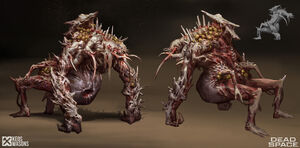
A Brute Necromorph composed of multiple dead hosts' combined biomass.
While Slashers are overall the most common type of Necromorph, the creature created during infection largely depends on location and circumstance. For example, Lurkers are usually created from the infant-like organ banks used for medical transplants, human-born infants or, in other cases, dogs, while Guardians are created from corpses affixed to the growing Corruption - the Necromorphs' "habitat changer".[15] Certain Necromorphs are composed of several human bodies (see Brute or Tripod), which is an indication that some form of intelligence is at work; allocating biomass for specific use.
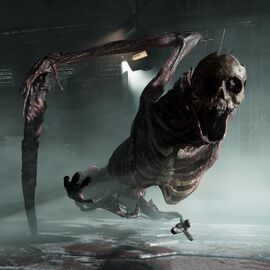
A Slasher continues to operate despite the damage to its body.
All Necromorphs are extremely hardy and capable of surviving in lethal environments such as the vacuum of space. This implies a total lack of respiration or reliance upon vascular activity, which explains the Necromorphs' resistance to wounds that would cause massive blood loss due to hemorrhaging in humans. The most effective way to defeat the majority of Necromorph forms is through dismemberment; by cutting off a Necromorph's means of mobility, the creature will collapse and be rendered seemingly inert, although, even in this state, the Marker signal will continue to permeate their body, making minute changes to their structure and causing their cells to continue living.[16] Many Necromorphs also feature yellow, luminescent tumor-like growths or pustules filled with bile;[17] these sacs often explode violently when ruptured.
Behavior and Ecology[]
- "These Necromorphs have no intelligence - how could they? Yet there's clear, if rudimentary purpose behind their actions, especially the gathering of corpses. They're clearly following some drive to kill living organisms and gather biomass. But where does this drive come from? How does it command them? Do all Necromorphs converted by a Marker share this... bond? Pack instinct? Or is the Hive Mind demonstrating a genuine telepathic communication - perhaps the first ever observed? How painful to admit that the Marker's horrors still hold a fascination for me."
- —Dr. Terrence Kyne[18]
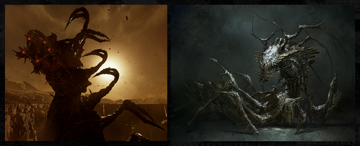
Nexus organisms, also known as "Hive Minds", serve as conduits for the Marker's control signal and as Necromorph ground commanders.
Necromorphs are highly aggressive; they will attack any living being on sight, regardless of species, for the sole purpose of creating corpses and spreading the infection as quickly as possible. In order to more effectively hunt their prey, Necromorphs share a form of collective intelligence that allows them to act in a coordinated manner. This shared consciousness originates from Nexus Necromorphs or "Hive Minds", large creatures that are able to receive the Markers' control signals and broadcast orders to the smaller Necromorphs.[19][20]

Marker 3A surrounded by Necromorph Corruption created by its signal.
While the Markers create the Necromorphs by recombining dead flesh through their signal, they do not directly guide the creatures beyond sending out general commands to the Nexus forms, with the Necromorphs behaving as little more than animals with an insatiable drive to hunt and gather biomass. As such, the creatures will attack all living beings, even individuals who are under the influence of the Marker[21] or otherwise trying to further the Markers' goal.[22]
To protect living beings who are useful to its plans, such as those who are better suited to become "architects" and build more Markers, the Marker signal creates a "dead space" around the artifact - the "eye of the storm" - which forces Necromorph tissue into dormancy.[6] This allows the Marker to draw useful individuals to its base where they will be protected from Necromorph attacks, while their close proximity to the Marker ensures that it can easily infect their minds and bend them to its will.[23]
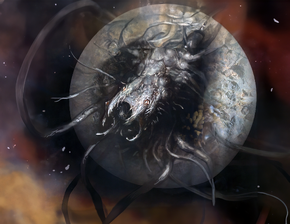
The Brethren Moons are highly intelligent, moon-sized necrotic lifeforms that are believed to be the source of the Marker signal.
The Necromorphs' control signal can be traced from the Hive Minds to the Markers and, ultimately, to the Brethren Moons: highly intelligent cosmic entities that are formed following a Convergence Event, and are capable of creating Necromorphs and manipulating living beings from incredible distances via the Marker signal. The Brethren Moons are linked to one another through a telepathic network spanning the stars, which they use to communicate as the Markers' influence affects other sentient species, leading them to build more Markers, cause Necromorph outbreaks and continue to expand the network through a subsequent Convergence Event.
Despite being viewed as merely "deranged killing machines",[16] Necromorphs sometimes display tactical planning and cooperative behavior: they commonly hunt in small packs of mixed individuals with semi-specific roles, and use stealth, ambush, or group tactics to outsmart their victims. This requires a degree of strategic thinking, and points to a certain amount of individual intelligence and communication. Examples of this include using ventilation shafts to sneak up on prey, playing dead, not attacking until the victim is well within striking range or their back is turned, or using a lure to draw known threats into an ambush.

Several different types of Necromorph.
Necromorphs not currently engaging a non-Necromorph target have been observed as performing several different behaviors. Many will wander aimlessly, almost passively, with no real destination, until they are aware of a new victim to kill that they will immediately engage. Some will drag bodies to a different location, possibly to make it easier for an Infector to find. Some will hide themselves inside ventilation shafts, setting up new or resetting previous ambush sites. Some will simply stand in place, waiting for a new victim to come to them. When a target is present but out of range, they will often watch the victim and attempt to intimidate them with loud growls and threatening poses. Feeders are also observed to do what appears to be eating when no living beings are nearby.
Of the Necromorph "foot soldier" forms, Stalkers appear to have the strongest sense of pack cohesion and individual intelligence demonstrated, as they will often peek around corners to lure victims while another will charge from a different direction. They are also the only known Necromorphs to directly communicate with one another, as the noises they make seem to hold some significance, e.g. the Stalkers will make a noise while or just after Isaac Clarke has moved his location, alerting the other Stalkers.
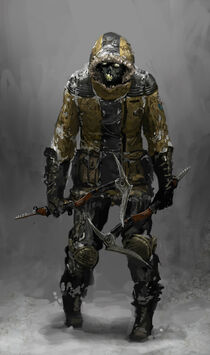
Fodders can fool their prey by retaining their hosts' clothing and tools before revealing their monstrous form.
A form of Necromorphs called Fodders are also seen still carrying the melee weapons previously used by their hosts, showing that they either have a very slight form of intelligence or, quite simply, their hunting behavior may be actualized based on rudimentary context clues from their surroundings and environment. Another example of Necromorphs using contextual adaptation as a form of intelligence are the Creeper and Shambler. When the Creepers take over the corpse of a S.C.A.F. or Circle soldier, they will wield and shoot the corpse's weapon, albeit in a rudimentary and clumsy manner with extremely poor accuracy, indicating a low level of fine motor control.
In Dead Space 3, it can be seen that when Necromorphs are left idle for years at a time, they curl up in a hanging patch of the Corruption to conserve their energy and wait for unsuspecting prey. This results in the Necromorphs becoming mummified and fungus-like in the process if left in this state. An example of this is seen when Isaac Clarke and John Carver enter the dilapidated CMS Roanoke, a 200-year old ship in orbit over Tau Volantis.
Trivia[]
- The Necromorphs' creation and design were led by Ben Wanat, who served as production designer on Dead Space and Dead Space 2 and as creative director of Dead Space 3. Ben Wanat was also responsible for developing the lore of the Necromorphs, the Markers and the Brethren Moons alongside franchise co-writer Chuck Beaver, with this lore being firmly established at some point between the release of Dead Space and Dead Space 2, as the two developers were left in charge of fleshing out the universe for the sequels following the success of the original game.[24]
- Necromorphs share similarities to a number of other creatures featured in previous works of science fiction:
- Necromorphs were partially inspired by the "Xenomorphs" from the Alien movies.[25] Both species parasitize human bodies in order to reproduce, both have names which end with the word "morph", and both will travel by vent or other areas that they climb from for the element of surprise.
- Necromorphs also have traits resembling the parasitic alien life-form from John Carpenter's The Thing, which greatly inspired their design.[25] The Thing is an alien life-form that infects and assimilates its victims into a perfect imitation of the former human and can replicate their traits, but is also able to mold their body into new forms that allow it to fight, such as a set of teeth in the rib cage and large tentacles.
- This parallel is taken further in Dead Space 3, where the primary setting is on a frozen planet, similar to The Thing's Antarctic setting. The snowsuit-wearing Fodder forms encountered in 3 also share traits with The Thing's creature, using a human-like façade to conceal their tentacled interior, while the ghastly light emitted from their faces resembles the famous poster from John Carpenter's film.
- The term "Necromorph" is a neologism comprised of the root words "necro" (from the Greek word νεκρός, nekrós) meaning "dead" and "morph" (from the Greek μορφή, morphḗ) meaning "form" or "shape"; thus "Necromorph" can be translated into the synonymical morphologically parsed term "Dead-Form", an apt name for the creatures given their nature.
- In Dead Space (2023), the Guest Consultant's Suite of the USG Ishimura's Crew Deck has what appears to be fMRI scans of the Necromorphs, with the pictures showing dark cerebral regions consistent with a lack of neural activity. This indicates that Necromorphs indeed do not make use of the host's brain, further lending credence to their name.
- According to The Art of Dead Space, an early idea for the Necromorphs was that their appearance would resemble bloated, translucent corpses that had floated ashore on a beach. However, this concept was put aside and later changed to how they look now. The creative team of Dead Space created hundreds of concepts for the look of the Necromorphs.
- As seen below in the gallery, the developers seemed to first go for an insect-like look of the Necromorphs after scrapping the bloated corpse-look, that later changed into more human-like. However, they kept some insect characteristics for the Necromorphs for the final productions.
- According to the design team, the key idea of the Necromorphs is that they are made up entirely of human body parts: scythe arms were once the bones of the human host, tentacles are made up of a host's intestines, etc. The result is that the entirety of the Necromorph is comprised of re-purposed organic parts from a previous host or hosts. According to a 2010 article, the team studied medical, autopsy, and accident photos in order to recreate the effect of a ravaged human body;[26] however, The Art of Dead Space later stated that the tale of the developers studying real accident photos is something of a myth, and that the team instead bought and studied animal meat.
- For Dead Space 3, the design team decided to introduce a more mummified look for the Necromorphs. Ben Wanat stated that, due to the third game's radically different setting, he decided to explore a direction for the creatures that took great inspiration from mummified remains, which he felt could trigger a different type of unsettling feeling compared to the "fresh" look of the Necromorphs from previous games.[25][27]
- As seen in Dead Space 2's multiplayer, Necromorphs can see neuron strands in the human body. It is possible to speculate that Necromorphs can sense electric impulses (neurokinetic impulses). This would explain why the Pukers, having had their sensory organs melted off, are able to accurately determine the location of the player and aim their acidic spit at them.
- Despite being seen using new models in Dead Space 3, the Enhanced versions of most Necromorphs encountered in game still use the Dead Space 2 models (i.e. Slasher, Leaper, Puker, etc.).
Concept Art[]
Dead Space (2023)[]
Dead Space (2008)[]
Dead Space 2[]
Dead Space 3[]
Other[]
Ben Wanat's Early Concepts[]
Sources[]
- ↑ List of whispers in Dead Space (2023)
- ↑ 2.0 2.1 The Art of Dead Space page on the Markers
- ↑ 3.0 3.1 Dead Space 3 Dev Team Edition
- ↑ 4.0 4.1 4.2 Dead Space 3 Dev Blog: The Markers
- ↑ 5.0 5.1 Log:Nicole and Dr. Kyne
- ↑ 6.0 6.1 Log:There's A Dead Space
- ↑ 7.0 7.1 Log:Recombination Study
- ↑ Log:Sterile Instruments
- ↑ Log:Re-Animate
- ↑ Log:Alien Artifact 08
- ↑ Dead Space 3 - The Story so Far
- ↑ Log:Negotiations
- ↑ Dead Space 2 - Daina: The Marker you found imprinted your brain with a self-replicating signal. The longer you're awake, the more the signal spreads.
- ↑ Get Deep Inside ‘Dead Space 3’s’ Necromorphs Before They Get Deep Inside You
- ↑ Log:Med-Sci Reports
- ↑ 16.0 16.1 Log:Alien Artifact 03
- ↑ Dead Space (2023) - Nicole: The chest contains a yellow bile seen in other specimens. I've seen this bile react to dead or bioprosthetic cells. The dead tissue is absorbed, recombined, then... reanimated. The bile shares genetic markers with human DNA, and that growth on the walls. It's all connected to the Marker from Aegis VII.
- ↑ Log:Nexus Organism
- ↑ Dead Space 3 - Santos: The scientists called it the "Nexus". They thought these bigger specimens acted as conduits for the [Marker's] control signal, broadcasting it to the smaller forms.
- ↑ Dead Space (2023) - "Nicole": The Hive Mind will obey.
- ↑ Dead Space (2023) - "Nicole": The planet is restless. Hungry. It'll try to eat us alive.
- ↑ Dead Space 3
- ↑ Dead Space: Catalyst
- ↑ Dead Space interview with Chuck Beaver, Ben Swanson and Nick Braccia
- ↑ 25.0 25.1 25.2 The Art of Dead Space
- ↑ Wired: Dead Space 2 Game Designers Explore Some Really Gross Anatomy
- ↑ How the Dead Space 3 team created new hellish monsters
| ||||||||||||||||||||||||||||||||||||||



